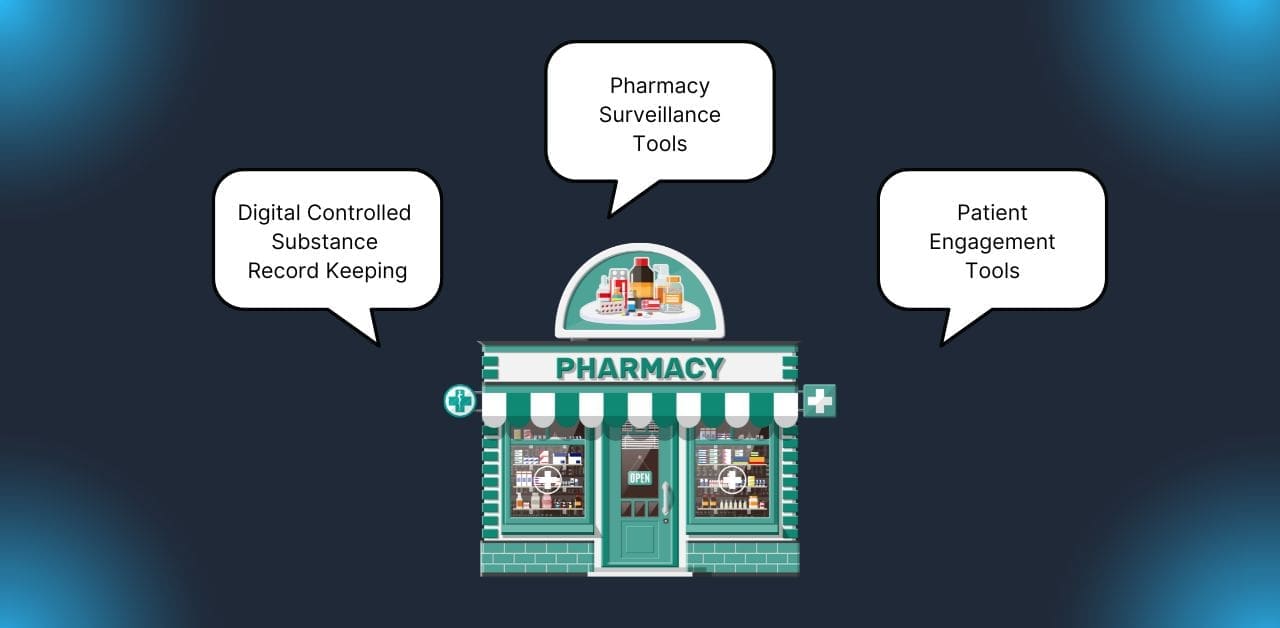The opioid crisis continues to demand innovative solutions from healthcare providers, with opioid stewardship technology playing a crucial role in ensuring safe and responsible dispensing through opioid stewardship programs. Traditional approaches often rely on manual processes, making them susceptible to human error and time constraints, which limits pharmacy innovation and hinders effective opioid stewardship management.
However, technology presents a transformative opportunity for pharmacy innovation, empowering pharmacists and staff to bolster their efforts through automation, real-time data, and enhanced patient engagement. This blog explores different types of opioid stewardship technology, including digital controlled substance (CS) record-keeping systems, pharmacy surveillance tools, and patient engagement technologies.
Digital Controlled Substance Record Keeping
For pharmacists, opioids fall under the Schedule II (CII) category of controlled substances, meaning they are subject to stricter regulations. Manually tracking CIIs using paper logs and invoices is a laborious and error-prone process. Pharmacists often spend countless hours reconciling inventory, investigating discrepancies, and preparing for audits. This time-consuming burden detracts from their ability to focus on patient care and can negatively impact staff morale. However, digital controlled substance (CS) record keeping systems offer a streamlined alternative, automating these tasks and freeing up valuable resources.
A robust digital CS record-keeping system is integral to an effective opioid stewardship program and pharmacy innovation because it provides unparalleled transparency in tracking opioids. Here’s how a properly integrated system can achieve this:
- Real-Time Inventory Insights: By centralizing data, a digital CS record-keeping system provides a comprehensive and up-to-date view of all opioid-related transactions. This real-time visibility enables pharmacists to quickly identify discrepancies, potentially preventing missing pill issues and enabling prompt investigations.
- Simplified Investigations: Opioid discrepancies in controlled substance inventory can trigger stressful and time-consuming investigations. A proper digital CS record-keeping system can simplify this process by providing tools that pinpoint the source of errors, making investigations more efficient and less disruptive to workflow.
- Reduced Regulatory Risk: Digital CS record-keeping systems have security features and pre-formatted templates that enhance compliance with regulatory requirements, mitigating the risk of fines and sanctions. Combined with automated reporting, pharmacies can confidently demonstrate compliance.
Pharmacy Surveillance Tools
While digital CS record-keeping systems focus primarily on efficiency and accurate inventory compliance, pharmacy surveillance tools expand a pharmacy’s capabilities to proactively intervene in opioid dispensing. Traditionally, pharmacists rely on retrospective data analysis, often identifying issues after they occur. By integrating a digital CS record-keeping system with an advanced clinical surveillance tool, pharmacists can now gain immediate insights into opioid use patterns, facilitating timely and targeted interventions. A key benefit of many pharmacy surveillance tools is the ability to calculate and track Morphine Milligram Equivalent (MME) scores. MME serves as a standardized measure of opioid potency, allowing pharmacists to compare different opioids and assess the overall opioid burden on a patient. High MME scores can indicate potential risks for adverse events and opioid use disorder, prompting pharmacist intervention. Real-time MME tracking empowers pharmacists to:
- Identify patients prescribed high doses of opioids and engage in conversations about alternative pain management strategies.
- Monitor patients receiving multiple opioids or opioids in combination with other medications that may increase risks, such as benzodiazepines.
- Collaborate with prescribers to adjust opioid regimens, ensuring patients receive appropriate pain relief while minimizing risks.
Patient Engagement
The impact of opioid stewardship technology extends beyond pharmacy innovation, playing a vital role in improving patient engagement and promoting responsible opioid use. Pharmacies can leverage various tools to educate patients, monitor adherence, and provide ongoing support. Here are some examples of how opioid stewardship technology can be used for patient engagement strategies:
- Personalized QR Codes: Pharmacies can incorporate personalized QR codes on prescription labels or receipts, linking patients to medication-specific videos in their preferred language. These videos provide clear and accessible information about potential side effects, safe storage and disposal, and signs of opioid misuse.
- Mobile Apps and Telehealth: Mobile apps and telehealth platforms provide convenient channels for patient education, medication reminders, and virtual consultations with pharmacists. These tools offer ongoing support and empower patients to actively participate in their pain management.
- Medication Adherence Monitoring: Encouraging patients to consent to and engage with medication adherence monitoring technology helps pharmacies promote safe opioid use. By having patients engage with things such as wearable sensors, biomarker testing, and directly observed therapy (DOT), pharmacies can monitor adherence patterns, identify potential risks of misuse, and provide targeted support to ensure safe and effective opioid use.
Embracing Opioid Stewardship Technology for Pharmacy Innovation
By embracing opioid stewardship technology, pharmacies can transform their opioid stewardship programs from reactive to proactive, ensuring safer and more effective patient care. Automation streamlines operations, real-time data empowers pharmacists with actionable insights, and enhanced patient engagement fosters responsible opioid use. As the opioid crisis persists, leveraging technology will be crucial for pharmacy innovation, helping pharmacists and staff combat this public health challenge and safeguard patient well-being.

